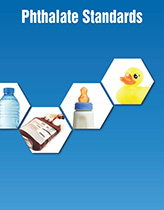Click "Allow Cookies" to consent to storing cookies on your device to improve your experience on our site. Learn more.
Phthalate Reference Standards
Also known as plasticizers, Phthalates are a class of chemical compounds that are generally used as an additive to improve flexibility and durability in plastic. They are also widely applied in cosmetic and personal care consumer products such as hair spray, nail polish and fragrances. Prolonged exposure to phthalates has been linked to a series of adverse health effects in human such as cancer, endocrine disruptions, and reduced fertility.
Regulatory bodies such as the US Food and Drug Administration (USFDA) and the European Chemicals Agency (ECHA) are regularly updating their lists of phthalates banned from use in consumer products.
Phthalates Categories
Use the links below to navigate to specific types of Phthalate Standards.
Single Component Phthalates
Isophthalates, Terephthalates, and Monophthalates
Deuterated Phthalates
Phthalate Technical Mixtures
Other Plastic Additives
Multi-Component Phthalate Mixes
The Consumer Products Safety Commission (CPSC) has proposed banning the use of several phthalates in materials for children’s toys. In 2008, a congressional edict banned dibutyl, n-butyl benzyl and di-2-ethylhexyl (DEHP) phthalates as potential health risks. Diisononyl (DINP), di-n-octyl (DNOP) and diisodecyl (DIDP) phthalates also were banned on an interim basis. CPSC’s advisory panel now recommends a permanent ban on DINP, but says the ban on DNOP and DIDP should be lifted. In addition, the panel is considering a ban on diisobutyl, di-n-pentyl, di-n-hexyl and dicyclohexyl phthalates.
Terephthalates
Monophthalates
Monophthalate esters are the primary phthalate metabolites formed via hydrolysis of one ester bond. These compounds are thought to be toxic agents; and are receiving interest as a possible human health issue. Studies have shown that they can produce estrogenic and immune-suppressive effects in humans. AccuStandard offers monophthalates including the mono-Ethylhexyl (mEHP) which is the metabolite of the plasticizer with the greatest yearly production and use on a global basis.
The high molecular weight (HMW) phthalates have more than six carbons in the backbone; and are synthesized from phthalic acid and mixtures of C9 and C10 alcohols. The two major HMW products are diisononyl phthalate (DINP) and diisodecyl phthalate (DIDP). Attention has now turned to the analysis of these compounds as they are becoming major players in the plasticizer marketplace. However, due to the synthesis process, GC separation of DINP and DIDP results in a cluster of peaks corresponding to different isomers. Consequently, different analytical approaches based on soft ionization techniques and MS detection have been documented in the literature (1). These new approaches can provide another tool to scrutinize the amounts, environmental fate and potential health effects of these HMW plasticizers.
Other Plastic Additives
Concern over enviromental and health-related factors associated with phthalates has led to restrictions of use in a wide array of products. This has resulted in the plastics industry generating a variety of alternatives. In response, AccuStandard has developed a phthalate replacement product line comprised of 42 compounds representing 18 chemical classes.
Adipic Acid Derivatives
Azelaic Acid Derivatives
Benzoic Acid Derivatives
Benzotriazol Derivatives
Dimer Acid Derivatives
Epoxy Derivatives
Fumeric Acid Derivative
Glycerol Derivatives
Isobutyrate Derivatives
Maleic Acid Derivatives
Mellitates
Myristates
Nitrogen Containing Compounds
Olieic Acid Derivatives
Palmitic Acid Derivative
Phenol Derivatives
Phosphoric Acid Derivatives
Ricinoleic Acid Derivatives
Sebacic Acid Derivatives
Succinic Acid Derivative
Sulfonic Acid Derivatives
Stearic Acid Derivatives
Need Assistance with Phthalate Standards?
To find additional Phthalate Standards, you can shop our full selection here.
If you still don’t see what you are looking for, reach out to techservice@accustandard.com and we can make a recommendation or create a custom product for you.


